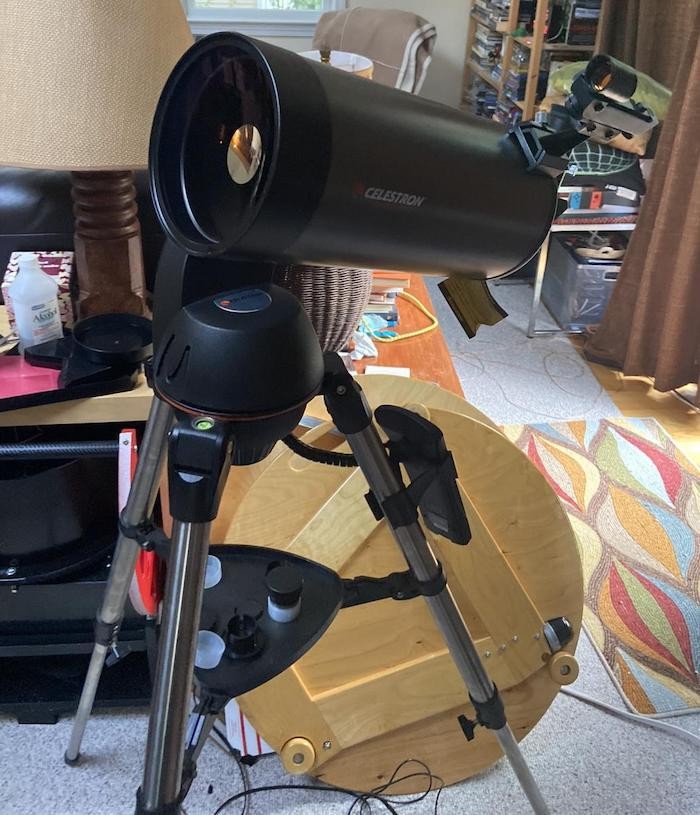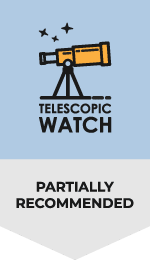Optical Tube Overview
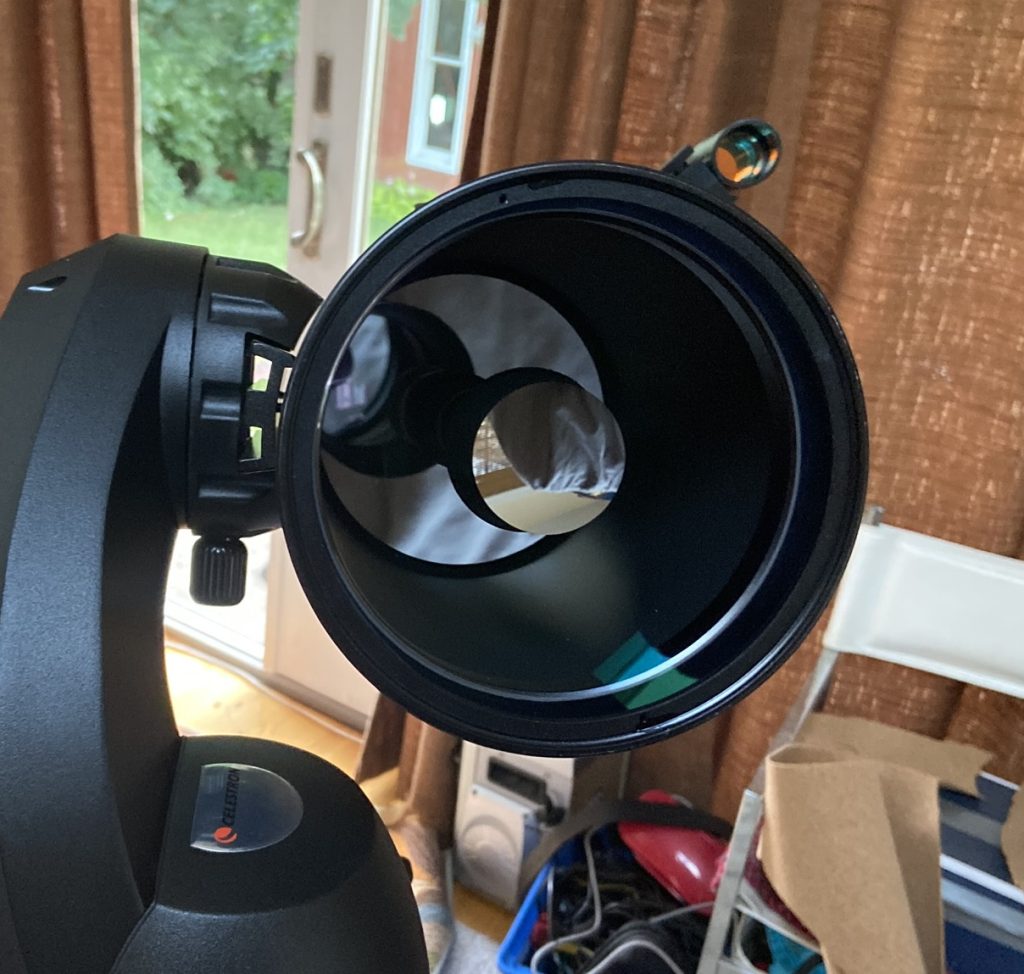
- Stopped-down Aperture
The Celestron NexStar 127SLT computerized telescope is a 127mm f/12 Maksutov-Cassegrain with a focal length of around 1500 mm. At least that’s what Celestron says. But in practice, I found out that the primary mirror of the Celestron NexStar 127SLT Mak is slightly undersized, stopping it at about 120 mm in aperture. This is a minimal reduction, I agree. But it does make the scope a half f-stop slower, i.e., f/12.5 from the stated f/12.
- Focusing and Image Shift
Focusing the NexStar 127SLT is accomplished in the same manner as pretty much all Maksutov- and Schmidt-Cassegrains: by turning a knob on the back of the optical tube that slides the primary mirror on a threaded rod inside the tube, as shown in the diagram below.
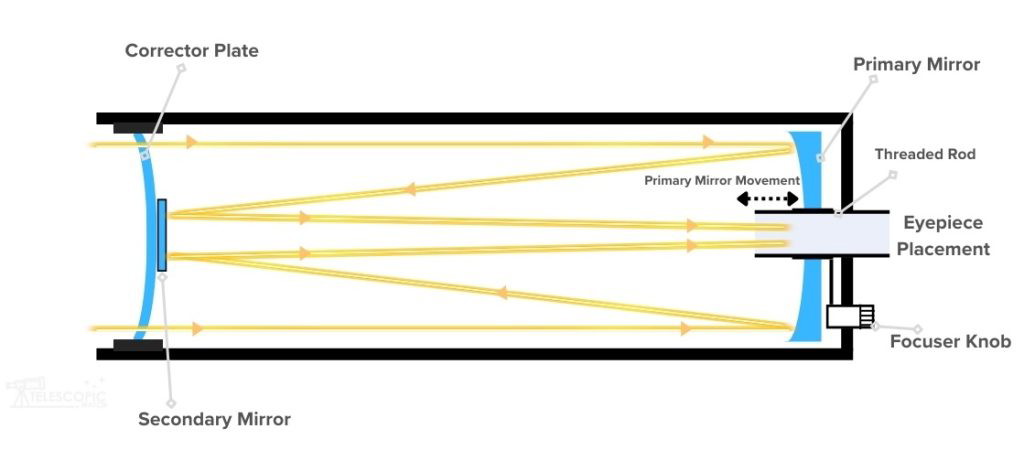
I can say for sure that this system works. But due to the mirror slightly wobbling on the rod when it moves, it can cause an issue called image shift (the image appearing to rock back and forth). I only experienced a relatively low amount of image shift with the 127SLT, so I don’t want you to expect it to be a problem for visual use or astrophotography.
- Optical Tube’s Compatibility with Other Mounts
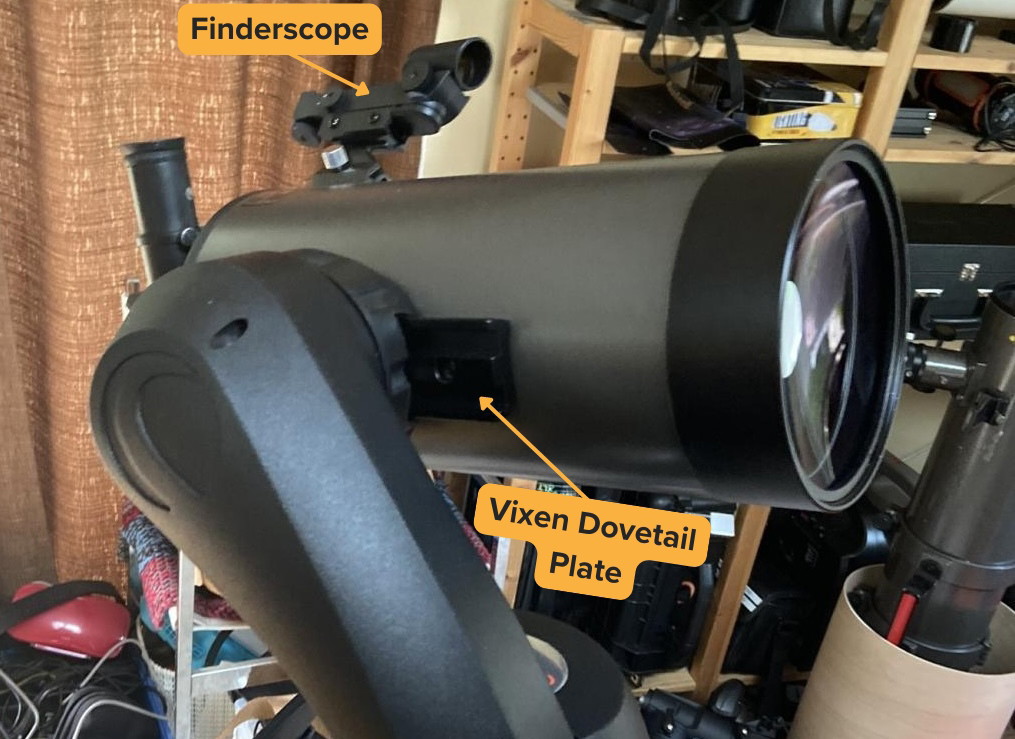
The NexStar 127SLT has a Vixen dovetail plate mounted on the right side of the optical tube. It’s sufficiently long that I can slide the scope on its mount to balance the scope if it is slightly front-heavy or back-heavy. I can also put the scope on a manual alt-az mount or an equatorial mount if I desire.
My Take On The Accessories
The Celestron NexStar 127SLT Maksutov comes with two eyepieces: a 25mm Kellner for low power (approximately 60x) and a 10mm Kellner for medium-high power (approximately 150x). These eyepieces worked pretty well when I tried. But Plossls would’ve been a little better and are usually what I’d expect at the 127SLT’s price point.
The 127SLT’s diagonal is a prism, and a nice one at that. It’s unlike the cheap diagonals I’ve seen being supplied with many entry-level scopes, which are cheap mirrors that aren’t very flat and tend to offer us dim and fuzzier images.
The NexStar 127SLT’s finderscope is the same generic “StarPointer” red dot LED device that comes on almost every beginner scope nowadays. I’ve found that it is well-made and sufficient for aligning the 127SLT’s GoTo system. You probably won’t have to use it again during your observing session once alignment is complete.
Incompatibility with Schmidt-Cassegrain Accessories
The Celestron NexStar 127SLT has a 1.25” visual back with a different thread system than Schmidt-Cassegrain accessories use. You can buy an aftermarket adapter that allows the use of Schmidt-Cassegrain visual backs, adapters, or a 2” diagonal.
A 2” diagonal along with long focal length eyepieces vignette the views slightly with the 127SLT, but a 2” wide-angle eyepiece allows us to achieve a wider true field of view. I had an uncomfortable level of vignetting with anything with a field stop of over 35mm or so. So I’d suggest you keep this in mind when shopping for eyepieces.
My testing also showed that an f/6.3 reducer meant for Schmidt-Cassegrains vignetted the views severely with the NexStar 127SLT. So better not to use it with the 127SLT.
The Barely Adequate Mount
The NexStar SLT mount is an evolution of the NexStar GT mount, which has been around since the early 2000s.
I believe that the 127mm Maksutov optical tube is about at the limit of what the SLT mount can handle. Other telescopes sold with the SLT mount, namely the 102mm f/6.5 refractor (NexStar 102SLT) and the 130mm f/5 Newtonian (NexStar 130SLT), are really pushing its capabilities and are wobbly as a result. The 127mm Maksutov optical tube is lighter and shorter than both of those, thus putting less strain on the mount.
The Mount’s GoTo Functionality & The Issues
The SLT mount is a GoTo. That means you just have to line it up with a couple stars when setting up the telescope. Then it loudly and automatically swings over to and tracks the target of your choice.
The NexStar SLT’s hand controller offers a database of about 4,000 objects. But I’d expect you to have a hard time observing all 4,000 of said objects because a good chunk of them are invisible or incredibly boring with the 120-mm aperture of the NexStar 120SLT.
The SLT mount needs 8 AA batteries, which, in my experience, get used up by the end of the second observation session or so. Obviously, that’s inconvenient and can be expensive for anyone. So I highly recommend biting the bullet and buying a dedicated DC power supply.
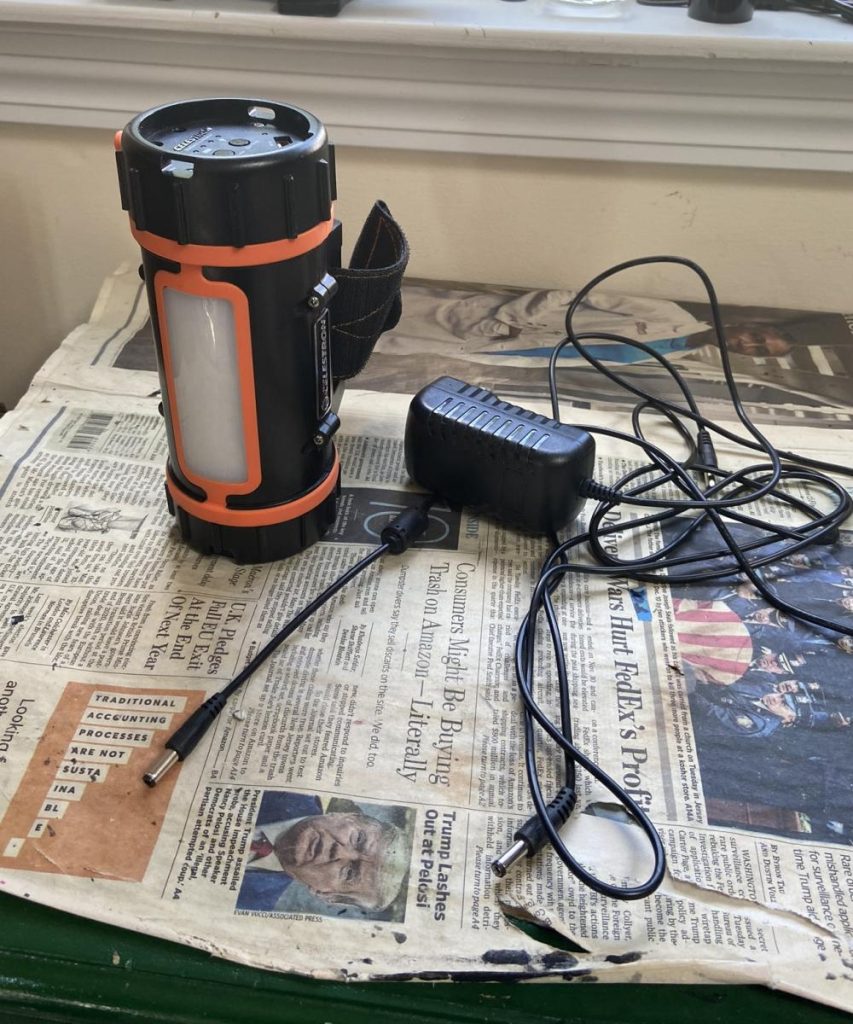
But I’d warn you not to forego the batteries in the scope. If the dedicated power supply disconnects for even an instant when the battery compartment is empty, the scope will shut down, and we’ll have to realign it before continuing.
The scope also lacks an internal clock, so I have to set the time and date again every time I use it.
Should I buy a Used Celestron NexStar 127SLT?
The Celestron NexStar 127SLT Maksutov-Cassegrain is a great deal if you can get it used. Make sure to check that the electronics work and that the mount moves smoothly.
And if it’s an older unit with a non-USB hand controller, be prepared to pay a bit less.
Alternative Recommendations
The Celestron NexStar 127SLT has great optics, but it’s hobbled by its stopped-down aperture, less-than-adequate mount, and high price tag for what you get. There are certainly worse choices, but we have a lot of alternatives you might want to consider first, even if you think the 127SLT is right for you.
Under $700
- The Apertura AD8 offers nearly triple the light gathering ability and about double the resolving power of the NexStar 127SLT, with a shorter focal length and 2” dual-speed Crayford focuser permitting a much larger possible true field of view – perfect for viewing deep-sky objects. The included accessory bundle is of excellent quality, and the full-sized Dobsonian mount stands on its own and is rock-steady, making finding and tracking objects by hand a breeze.
- The Sky-Watcher Virtuoso GTi 150P offers a significant (64)% boost in light gathering ability compared to the NexStar 127SLT, and like the 127SLT, it features fully motorized tracking and GoTo – but controlled with your smartphone or tablet instead of a hand controller and has the ability to push the telescope around the sky manually. The collapsible tube of the Virtuoso GTi 150P makes it just as compact as the NexStar 127SLT, and the tabletop mount is quick to set up and use. The 150P’s short focal length also allows it to attain a much wider possible true field of view, making it perfect for viewing deep-sky objects. The cheaper Heritage 150P is identical to the Virtuoso GTi 150P, apart from the lack of electronics, should your budget not permit the Virtuoso GTi or the GoTo doesn’t interest you.
- The Sky-Watcher Virtuoso GTi 130P has slightly more light gathering ability than the NexStar 127SLT, in addition to a shorter focal length that yields a much wider achievable field of view. The GTi 130P can be aimed manually even with its electronics powered on, and its fully motorized tracking and GoTo capabilities are controlled entirely with your smartphone or tablet. The collapsible tube makes it super-compact too. The all-manual Heritage 130P is identical to the GTi 130P, apart from lacking GoTo and makes for a superb budget alternative.
- The Celestron Astro-Fi 130 rides atop an updated version of the SLT mount supplied with the NexStar 127SLT, with beefed-up tripod legs for extra stability and ditching the hand controller for the SkySafari or Celestron SkyPortal app on your phone or tablet. The 130mm f/5 optics—the same as the Heritage/Virtuoso 130mm reflector and 130SLT—provide a wider field of view and slightly brighter images than the 127SLT, too. You can’t aim this scope manually, however, unlike the Virtuoso GTi telescopes, and the price is a bit high.
- The Celestron Astro-Fi 102’s aperture is a little smaller than that of the NexStar 127SLT, but between the steadier tripod and the ease of use thanks to the Astro-Fi mount and its smartphone/tablet control, you probably won’t be missing the 127SLT’s extra aperture much. The Astro-Fi 102 is perfect if you must have a Maksutov-Cassegrain telescope but don’t like some of the compromises that the 127SLT makes.
What Can You See?
The NexStar 127SLT’s f/12.5 focal ratio makes it a little more suitable for deep-sky than some of the competing GoTo Maksutovs, but it really still limits what I can see.
- The best deep-sky objects to observe with small scopes are large nebulae, which are so spread out that they’re simply invisible with the 127SLT, and open clusters, some of which don’t fit in the field of view even at low power.
- The scope’s meager 120mm aperture means I can’t resolve many globular clusters, and planetary nebulae big and bright enough for a 120mm scope are few and far between.
Really, the 127SLT is a lunar and planetary scope, and for that, you don’t need the GoTo at all.
- Mercury and Venus’ phases can be seen.
- The 120mm aperture is enough to resolve a few dark patches and the ice cap on Mars.
- Jupiter and Saturn display a wide array of features and moons.
- Uranus and Neptune, invisible to the naked eye, are uninteresting with the 127SLT and appear as little more than bluish dots.
Astrophotography: Useless for Deep-Sky and Decent for Planetary
The lightweight, alt-azimuth SLT mount combined with the 127SLT’s f/12.5 focal ratio means it is utterly useless for deep-sky imaging.
However, I could do a decent job imaging the Moon and planets with an inexpensive CMOS camera and a 2x Barlow lens. The only other prerequisite is a laptop with a decent amount of RAM and lots of hard drive space.
If you have a DSLR, you can also use it with a 2x or, preferably, 3x Barlow lens with or without a laptop (a laptop allows for more control over the camera) and get equally good results. But the DSLR will strain the mount more, so if you don’t already have a camera, I’d choose a CMOS instead.

